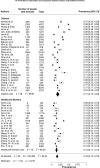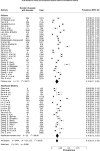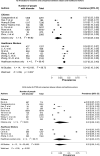Prevalence of symptoms of depression, anxiety, insomnia, posttraumatic stress disorder, and psychological distress among populations affected by the COVID-19 pandemic: A systematic review and meta-analysis
- PMID: 33285346
- PMCID: PMC7689353
- DOI: 10.1016/j.psychres.2020.113599
Prevalence of symptoms of depression, anxiety, insomnia, posttraumatic stress disorder, and psychological distress among populations affected by the COVID-19 pandemic: A systematic review and meta-analysis
Abstract
Objective: We conducted a systematic review and meta-analysis to estimate the pooled prevalence of depression, anxiety, insomnia, PTSD, and Psychological distress (PD) related to COVID-19 among affected populations.
Methods: We searched articles in Medline, Embase, APA PsycInfo, CINAHL, Scopus, and Web of Science. Random-effects meta-analyses on the proportions of individuals with symptoms of depression, anxiety, insomnia, PTSD, and PD were generated and between-group differences for gender, healthcare workers (HCWs), and regions where studies were conducted.
Results: A total of 2189 articles were screened, 136 full-text articles were assessed for eligibility. Fifty-five peer-reviewed studies met inclusion criteria for the meta-analysis (N=189,159). The prevalence of depression (k=46) was 15.97% (95%CI, 13.24-19.13). The prevalence of anxiety (k=54) was 15.15% (95%CI, 12.29-18.54). The prevalence of insomnia (k=14) was 23.87% (95%CI, 15.74-34.48). The prevalence of PTSD (k=13) was 21.94% (95%CI, 9.37-43.31). Finally, the prevalence of psychological distress (k=19) was 13.29% (95%CI, 8.80-19.57). Between-group differences were only found in HCWs (z=2.69, p < 0.05) who had a higher prevalence of insomnia than others.
Conclusions: Findings suggest that the short-term mental health consequences of COVID-19 are equally high across affected countries, and across gender. However, reports of insomnia are significantly higher among HCWs than the general population.
Keywords: Anxiety; COVID-19; Depression; Insomnia; Posttraumatic stress disorder; Psychological distress; Systematic review with meta-analysis.
Copyright © 2020. Published by Elsevier B.V.
Conflict of interest statement
No conflict of interest for any author.
Figures







References
-
- Al-Rabiaah A., Temsah M.H., Al-Eyadhy A.A., Hasan G.M., Al-Zamil F., Al-Subaie S., Alsohime F., Jamal A., Alhaboob A., Al-Saadi B., Somily A.M. Middle East respiratory syndrome-corona virus (MERS-CoV) associated stress among medical students at a university teaching hospital in Saudi Arabia. J. Infect. Public Health. 2020;13:687–691. doi: 10.1016/j.jiph.2020.01.005. - DOI - PMC - PubMed
Publication types
MeSH terms
LinkOut - more resources
Full Text Sources
Other Literature Sources
Medical
Miscellaneous

